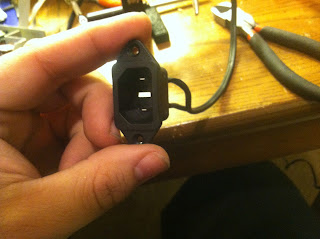I have made more progress in the past few days than I thought possible. Either I'm getting a lot better at what I do, or this wasn't as hard as I had anticipated, or some combination of the both. I'm guessing it only seems easy because I've worked with the '64 before. Anyhow, I've got quite the update today so sit back and enjoy!
I finally decided where to put all of the switches, plugs and ports on the falcon, so I started hacking. More specifically I started melting. I used my rotary tool to cut out the controller ports in the last post and that seemed to make a god-awful mess and was extremely hard to control precisely It was well enough on the controller port because it is shadowed well enough to not see the half-stick of hot glue holding it together... (it is very sturdy though lol)
So, that said, I had to find a better way to make holes. I ended up taking one of my many old soldering irons and basically turned it into a hot-knife. It "cut" through the plastic well enough to be a rough cut, that happened to soften the edges significantly. Enough so, in fact, that I could clean it up nicely with my razor. Here's some of the results:
The power port
The on/off switch: (I got rid of the reset button altogether)
The port side of the cartridge slot wired up. I actually got the buses backwards and had to re-solder the whole thing, but it comes with the territory I guess.
Here's a shot of the re-soldering process. It sucked... a lot, but it was needed. I'm glad I got this helping hand tool (thanks Caytee) or this would have been impossible.
The properly soldered socket
And I had to make sure all this actually works, so here's a pre-assembly demonstration video!
I did some more "hot knifing" for the cartridge slot. The pic didn't really come out, but you can see the general idea.
Here is the cartridge slot installed and hot glued in place. I had to use an absolutely ridiculous amount of hot glue to keep all those bus wires from shaking loose.
Here are a few shots of the nearly completed project. The only thing left in these shots is to screw the pieces back together, a little fine-tuning on the alignment of the cartridge slot and to secure all the guts with hot glue.
I ended up having to take a chunk out of the housing for the lights in the back to make room for the wiring from the socket to get the lid to close fully, I got all the screws back in place and it still boots like a charm :)
And now I present to you: THE MILLENNIUM 64!!!!!!!
A few side notes I feel worth mentioning:
I tested every game I've got and it seems to run flawlessly. I played OOT for about 4 hours and it wasn't even remotely warm, so my heat-sink seems to be more than enough.
I kept getting frustrated with the legs always folding in at the most inconvenient times, so I glued them into their standing positions. I also ended up using hot glue to secure the board, I had screws, but there really wasn't anywhere I could have gotten enough of them in to do any good.
Also I had to use a jumper pack instead of the memory expansion pack because, quite frankly, I can't afford one and I wasn't about to steal the one from Caytee's console (she would kill me lol) I did test out the expansion from hers and it works rather well. Plenty of clearance and room there to change it out later if I decide to.
I am about out of planned projects to work on so I'm open for suggestions. What would you all like to see in the future? I've got a game gear I am about to repair next week. If you all would like to read about it let me know in the comments and I'll chronicle it for you.
I'll post more videos for you later :)























